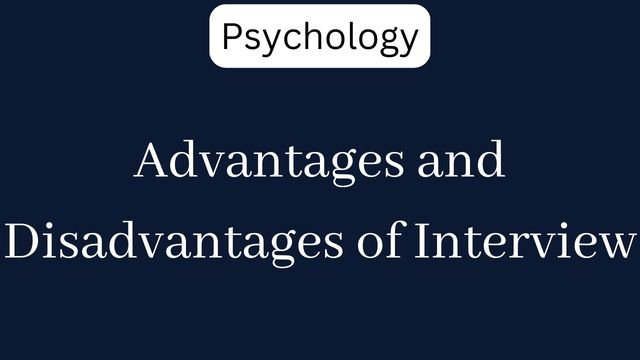Advantages and Disadvantages of Interview
Advantages of Interview :-
- What so ever is the type of interview it has some Advantages and Disadvantages,it is compulsory to throw light on them? After evaluating many review using interview techniques Gorden, ( 1969) described some advantages of interview techniques, which are as follows:
1. By interview the interviewer collects the desired information in a short time.
2. Interview is a type of technique in which the researcher becomes completely satisfied with the fact that he has made the right interpretation of the responses collected from the respondent.
3. In the interview technique there is flexibility in the questions which allows the researcher to find the intensive information in very less time. If the questions being asked is not understood by the interviewee than there is a facility to repeat the question in the interview technique. Such type of facility is not available in questionnaire method.
4. In this technique it is easy for the interviewer to control the situation, as a result of which the interviewer can ask the appropriate questions from the interviewee and along with this even the interviewee can answer the questions easily.
5. In the interview the interviewer receives some non- verbal cues from the respondent. In other words, the researcher can study the posture and gestures of the interviewee. On the basis of these signs the researcher is able to understand the meaning of the responses given by the interviewer.
Disadvantages of Interview :-
- Along with these advantages the interview technique has some disadvantages too, which are as follows:
1. The researcher framed a contradiction about the validity of verbal responses, because rarely any interviewee talks in a same way he responded during interview in his real life interaction. Therefore the decisions made on the behalf of verbal responses are not much valid.
2. It is seen that because of many other reasons the interviewer is not able to pay full attention to the responses made by the interviewee. Like if the interviewer is tired then he won’t be able to record the responses correctly. In such a situation it is not possible to come on worth conclusion.
3. The interview contains the quality of subjectivity in it. Generally it is seen that the interviewer reaches to the interview with some preassumphons, expectations, and p r e imagations. On the basis of this subjectivity the interviewer starts framing some necessary judgments, descriptions etc about the interviewee, because of which the reliability of the scores decreases.
4. Cicourel (1964) said that the interview context do not remain constant from one interview to the another. Sometimes the interview gets over with a calm environment but sometimes it gets over with a rude environment. As a result there occurs a difference in interview context and it becomes hard to come on any conclusion after the data collected from different interviewers.
5. Black and Champion (1976) said that, “The interviewing context is as free of regulation and conscious constraint as possible”. When many interviewers study a same problem then generally they interpret the information drawn from same interviewee in different styles. Some rates the same person at positive while the other rates the same person negative. As a result of which it becomes impossible to reach on any fix conclusion.
What is Interview
- Meaning and characteristics of interview Generally the face to face conversation between two or more persons to fulfill any specific purpose is called as interview.
- According to Denzen (1970), “An interview is any face-to- face conversational exchange where one person elicits information from another.” According to Kerlinger (1985), “The interview is face — to —face interpersonal role situation in which one person, the interviewer, asks a person being interviewed, the respondent, questions designed to obtain answers pertinent to research problem.”
Latest Post of Psychology :– Click Here
Important Points :-
- In the present chapter methods of psychology and measure of central tendency are discussed. Invigilation method is also called as observation method. In this method the observer studies the behavior of the organism or person.
- The case study method is used in clinical psychology to identify the symptoms of any disease and the cause responsible for it.
- Generally the conversation between two or more persons for any specific cause is called as an interview.
Survey method, experimental method introspection method are the basic psychological methods. - The measure of central tendency are- Mean, Mode, Median. In the present chapter frequency distribution, linear presentation, graphical presentation, frequency polygon and histogram are discussed.
1. The meaning of frequency is:
a) Scores
b) No. of repetitions of scores
c) Multiple of scores
d) None of these
Click to show/hide
2. Which of the method is not suitable for absolute frequency distribution?
a) Exclusive method
b) Inclusive method
c) Exact method
d) None of these
Click to show/hide
3.) Which is the formula for range?
a) (H-L)+1
b) (H+L)-1
c) (H-L)
d) NONE OF THESE
Click to show/hide
4. The symbol of size of class interval is:
a) Y
b) X
c) i
d) p
Click to show/hide
5. Which of the following is a graphical method?
a) Frequency polygon
b) Histogram
c) Bar diagram
d) All the above
Click to show/hide
